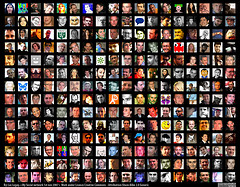
- Image by luc legay via Flickr
I was having a Twitter conversation late last week with Conner McCall about the definition of Twitter. Is it social networking? Is it a social network? I had asked:
“Twitter - Social Network? Still just microblogging? Somewhere in between?”
Conner wrote a follow-up post on the topic, in which he brought up some good points about why defining Twitter just shouldn’t happen.
Under most circumstances, I too shy away from defining and corralling social media tools into categories. Honestly, what’s the point sometimes?
However, I’m involved in some research through DigiActive concerning the use of digital tools in activism efforts around the world. When it came time to coding qualitative data on how people use their mobile phones for their advocacy work, I had separated out Twitter from all of the other social networks such as Facebook.
While going over the survey coding with the research team, someone suggested that several of the responses get combined in some way, and one of those ways was to lump Twitter in with the social networks. In fact, it was more like “Twitter is a social network so let’s put it in there.”
I really needed to push back on this because I see some key differences between the two, at least in terms of this project. Firstly though, some important similarities:
- One-to-many communication
- Everything is public within your “network”
- Information/data sharing
Aside from those major similarities, there are some differences that are too important to overlook for the purposes of trying to define how people use these tools to disseminate information and communicate with people.
In Conner’s thought process came one of the very reasons I needed to have a definition of Twitter. He said:
“It’s a free eco-system that allows you to talk about what you want, but by limiting you to 140 characters it keeps conversations clean and neat. E-mail, instant message, and social networks will all be around for a long time, but you get messages that take minutes to read where Twitter’s messages take seconds. This enforced brevity let’s you interact with a lot more people on a daily basis. Twitter just takes online communication and adds what events like Ignite add to presentations.”
It’s this quick, one-time communication aspect of Twitter that makes it very different than some of the longer-standing ways in which people interact on places like Facebook. You can have months-long campaigns on Facebook, where you gather fans and advocates for your cause. Or you can share photos or videos that can still be top-of-mind (read: in the first two pages of your friends’ Stream) the next day or several days. The interaction with information on a platform like Facebook is much more dynamic than it is on a platform like Twitter.
Twitter, on the other hand, is done-and-done. Information is disseminated real time, and often forgotten after that. This comes into play in any sort of activism effort because the length of time that Twitter is really useful is often much shorter than on social networks, and the reason that Twitter is used is usually much different than the reasons that Facebook is used.
Additionally, “this forced brevity [that] let’s you interact with a lot more people on a daily [or hourly] basis” is one of the reasons why people will use Twitter over social networks to mobilize efforts. Such was (sort of) the case in the Moldovan protests last month (note: the Twitter aspect of these protests was, in my opinion, overblown by much of the media).
The one tough thing about this question is that I’m not necessarily in disagreement with calling Twitter a social network. It is a network of people that you interact with socially, through social media (whatever that means), which is, at a high-level, what happens on Facebook and other “social networks.” I have a problem bunching them together when you get into the specifics of how those social networks work at a functional level.
In closing, while I like to also leave thing undefined a lot of the times and agree, for the most part, with Conner when he says that Twitter has no rules, there are times when the distinctions between these tools, like any set of tools, need to be highlighted. And usually these functional distinctions translate into at least small conceptual distinctions as well.
I would love to know your thoughts on how you might define social networks, or how you would make the distinction between Twitter and what everyone else considers social networks, or what you think about the whole definition thing in general!
Related articles by Zemanta
- What Is a Social Community? - Liz Strauss at Successful Blog … (jonggunlee.tistory.com)
- Women Prefer Blogs/Facebook To Twitter (sociableblog.com)
- Is Twitter really useless? (daniweb.com)



